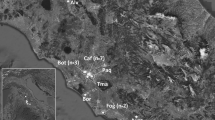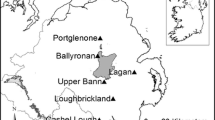Abstract
Among invasive species, floating plants have a great impact on aquatic ecosystems, forming dense mats that cause a great alteration of the physical and chemical water features. We experimentally assessed the effect of Azolla filiculoides mats on Mediterranean temporary waters using mesocosms with sediments from an invaded marsh and amphibian larvae from surrounding wetlands. Azolla filiculoides formed a dense mat over the water surface in the experimental tanks, which decreased pH and oxygen concentration, and increased nutrients, nitrogen and phosphorus compounds in the water compared to mesocosms lacking the exotic fern. Macrophyte abundance and richness were reduced under the Azolla mat. Invaded mesocosms also had higher phytoplankton abundance and different zooplankton composition, which was mainly characterized by higher abundance of juvenile copepods. Regarding amphibian development, tadpoles requiring a long developmental period, the western spadefoot toad, Pelobates cultripes, had significantly lower survival in the presence of A. filiculoides (4.8% compared to 60% survival in fern-free mesocosms). For tadpoles of the Mediterranean tree frog, Hyla meridionalis, which develop faster, we did not detect effects on survival, but on body size and physical condition of metamorphs. The formation of A. filiculoides mats produced a deterioration of the trophic web, as it caused most sources to be depleted in 13C and 15N. Primary consumers, tadpoles and zooplankton, were also 13C depleted, although the diet of tadpoles from Azolla mesocosms was mainly composed of the invasive fern. We therefore conclude that A. filiculoides has a negative impact on physical and chemical water features, reduces the richness and biomass of the submerged macrophyte guild and reduces survival and body condition of tadpoles. Overall, A. filiculoides causes substantial deterioration of the food web of the aquatic ecosystem.





Similar content being viewed by others
References
Alford RA (1999) Ecology: resource use, competition and predation. In: McDiarmid RW, Altig R (eds) Tadpoles: the biology of anuran larvae. Chicago University Press, Chicago, pp 240–278
Arribas R, Díaz-Paniagua C, Caut S, Gómez-Mestre I (2015) Stable isotopes reveal trophic partitioning and trophic plasticity of a larval amphibian guild. PLoS ONE 10(6):e0130897. https://doi.org/10.1371/journal.pone.0130897
Blindow I, Dietrich J, Möllmann N, Schubert H (2003) Growth, photosynthesis and fertility of Chara aspera under different light and salinity conditions. Aquat Bot 76:213–234. https://doi.org/10.1016/S0304-3770(03)00053-6
Boon PI, Bunn SE (1987) Variations in the stable isotope composition of aquatic plants and their implications for food web analysis. Aquat Bot 48:99–108. https://doi.org/10.1016/0304-3770(94)90077-9
Borisjuk N, Peterson AA, Lv J, Qu G, Luo Q, Shi L, Chen G, Kishchenko O, Zhou Y, Shi J (2018) Structural and biochemical properties of duckweed surface cuticle. Front Chem 6:317. https://doi.org/10.3389/fchem.2018.00317
Brönmark C, Hansson L-A (2005) The biology of lakes and ponds. Oxford University Press, Oxford
Brown CJ, Blossey B, Maerz JC, Joule SJ (2006) Invasive plant and experimental venue affect tadpole performance. Biol Invasions 8:327–338. https://doi.org/10.1007/s10530-004-8244-x
Bucciarelli GM, Blaustein AR, Garcia TS, Kats LB (2014) Invasion complexities: the diverse impacts of nonnative species on amphibians. Copeia 2014:611–632. https://doi.org/10.1643/OT-14-014
Chambers PA, Kalff J (1985) Depth distribution and biomass of submersed aquatic macrophyte communities in relation to Secchi depth. Can J Fish Aquat Sci 42:701–709. https://doi.org/10.1139/f85-090
Carrapiço F (2010) Azolla as a superorganism. Its implication in symbiotic studies. In: Seckbach J, Grube M (eds) Symbioses and stress. Cellular origin, life in extreme habitats and astrobiology, vol 17. Springer, Dordrecht, pp 225–241
Carrapiço F, Costa MH, Teixeira G, Baioa V (1998) A new evaluation of some Azolla blooms: the Guadiana cases. In: Proc 10th EWRS international symposium on aquatic weeds–management and ecology of aquatic plants, pp 249–252
Cronk JK, Fenessy MS (2001) Wetland plants. Biology and ecology. Lewis Publishers, Boca Raton
Curtis AN, Bidart MG (2017) Effects of chemical management for invasive plants on the performance of Lithobates pipiens tadpoles. Environ Toxicol Chem 36:2958–2964. https://doi.org/10.1002/etc.3859
de Tezanos PP, O’Farrell I (2014) Regime shifts between free-floating plants and phytoplankton: a review. Hydrobiologia 740:13–24. https://doi.org/10.1007/s10750-014-1943-0
Díaz-Paniagua C (1985) Larval diets related to morphological characters of five anuran species in the Biological Reserve of Doñana (Huelva, Spain). Amphibia-Reptilia 6:307–322. https://doi.org/10.1163/156853885X00317
Díaz-Paniagua C (1986) Sobre la reproducción de Hyla meridionalis en el S. O. de España. Doñana ActaVertebr 13:5–20
Díaz-Paniagua C, Gómez Rodríguez C, Portheault A, de Vries W (2005) Los anfibios de Doñana. SerieTécnica. Ministerio Medio Ambiente. OAPN, Madrid
Espinar JL, Díaz-Delgado R, Bravo-Utrera MA, Vilà M (2015) Linking Azolla filiculoides invasión to increased winter temperaturas in the Doñana marshland (SW Spain). Aquat Invasions 10:17–24. https://doi.org/10.3391/ai.2015.10.1.02
Fernández-Zamudio R, García-Murillo P, Cirujano S (2010) Germination characteristics and sporeling success of Azolla filiculoides Lamarck, an aquatic invasive fern, in a Mediterranean temporary wetland. Aquat Bot 93:89–92. https://doi.org/10.1016/j.aquabot.2010.03.011
Fernández-Zamudio R, Garcia-Murillo P (2013) Clonal reproduction of Azolla filiculoides Lam: implications for invasiveness. Limnetica 32:245–252. https://doi.org/10.23818/limn.32.20
Finlay JC, Kendall C (2007) Stable isotope tracing of temporal and spatial variability in organic matter sources to freshwater ecosystems. In: Michener RH, Lajtha K (eds) Stable isotopes in ecology and environmental science, 2nd edn. Blackwell Publishing, Maiden, pp 283–333
Florencio M, Fernández-Zamudio R, Bilton DT, Díaz-Paniagua C (2015) The exotic weevil Stenopelmus rufinasus Gyllenhal, 1835 (Coleoptera: Curculionidae) across a “host-free” pond Network. Limnetica 34: 79–84. https://doi.org/10.23818/limn.34.07
Galán P (2012) Declive de una población de Bufo calamita por invasión de la planta Azolla filiculoides. Bol Asoc Herpetol Esp 23:113–116
García-Murillo P, Fernández-Zamudio R, Cirujano S, Sousa A, Espinar JM (2007) The invasion of Doñana National Park (SW Spain) by the mosquito fern (Azolla filiculoides Lam). Limnetica 26:243–250
García-Novo F, Marín C (2006) Doñana, water and biosphere. Confederación Hidrográfica del Guadalquivir, Ministerio Medio Ambiente, Madrid
Gomez-Mestre I, Saccoccio VL, Iijima T, Collins EM, Rosenthal GG, Warkentin KM (2010) The shape of things to come: linking developmental plasticity to post-metamorphic morphology in anurans. J Evol Biol 23:1364–1373. https://doi.org/10.1111/j.1420-9101.2010.02016.x
Gosner KL (1960) A simplified table for staging anuran embryos and larvae with notes on identification. Herpetologica 16:183–190
Gratwicke B, Marshal BE (2001) The impact of Azolla filiculoides Lamm. On animal biodiversity in streams in Zimbabwe. Afr J Ecol 39:216–218. https://doi.org/10.1046/j.0141-6707.2000.00284.x
Holm-Hansen O, Riemann B (1978) Chlorophyll-a determination: improvement in methodology. Oikos 30:438–447. https://doi.org/10.2307/3543338
Hussner A (2012) Alien aquatic plant species in European countries. Weed Res 52:297–306
Janes R, Eaton JW, Hardwick K (1996) The effects of floating mats of Azolla filiculoides Lam. and Lemna minuta Kunth on the growth of submerged macrophytes. Hydrobiologia 340:23–26. https://doi.org/10.1007/BF00012729
Kulkarni SS, Gomez-Mestre I, Moskalik CL, Storz BL, Buchholz DR (2011) Evolutionary reduction of developmental plasticity in desert spadefoot toads. J Evol Biol 24:2445–2455
Middelboer AL, Markager S (1997) Depth limits and minimum light requirements of freshwater macrophytes. Freshwater Biol 37:553–568. https://doi.org/10.1046/j.1365-2427.1997.00183.x
Netten JJC, Arts GHP, Gylstra R, van Nes EH, Scheffer M, Roijackers RMM (2010) Effect of temperature and nutrients on the competition between free-floating Salvinia natans and submerged Elodea nuttallii in mesocosms. Fundam Appl Limnol 177:125–132. https://doi.org/10.1127/1863-9135/2010/0177-0125
Peters GA, Meek JC (1989) The Azolla-Anabaena symbiosis: basic biology. Ann Rev Plant Physiol Plant MolBiol 40:193–210. https://doi.org/10.1146/annurev.pp.40.060189.001205
Peeters ETHM, Neefjes REM, Van Zuidam BG (2016) Competition between free-floating plants is strongly driven by previously experienced phosphorus concentrations in the water column. PLoS ONE 11(9):e0162780. https://doi.org/10.1371/journal.pone.0162780
Pinero-Rodríguez MJ, Fernández-Zamudio R, Gomez-Mestre I, Díaz-Paniagua C (2018) Ranunculus peltatus develops an emergent morphotype in response to shading by the invasive Azolla filiculoides. Aquat Bot 152:32–35. https://doi.org/10.1016/j.aquabot.2018.09.007
R Core Team (2018) R: a language and environment for statistical computing. R Foundation for Statistical Computing, Vienna
Scheffer M, Szabó S, Gragnani A, Van Nes E, Rinaldi S, Kautsky N, Norberg J, Roijackers RMM, Franken RJM (2003) Floating plant dominance as a stable state. PNAS 100:4040–4045. https://doi.org/10.1073/pnas.0737918100
Schultz R, Dibble E (2012) Effects of invasive macrophytes on freshwater fish and macroinvertebrate communities: the role of invasive plant traits. Hydrobiologia 684:1–14. https://doi.org/10.1007/s10750-011-0978-8
Strayer DL (2010) Alien species in fresh waters: ecological effects, interactions with other stressors, and prospects for the future. Freshw Biol 55:152–174. https://doi.org/10.1111/j.1365-2427.2009.02380.x
Toft JD, Simenstad CA, Cordell JR, Grimaldo LF (2003) The effects of introduced water hyacinth on habitat structure, invertebrate assemblages, and fish diets. Estuaries 26:746–758. https://doi.org/10.1007/BF02711985
Wells KD (2007) The ecology and behavior of amphibians. University of Chicago Press, Chicago
Wilbur HM, Collins JP (1973) Ecological aspects of amphibian metamorphosis. Science 182:1305–1314
Williams AE (2006) Water hyacinth. In: G.D. Considine (ed) Van Nostrand's Scientific Encyclopedia. https://doi.org/10.1002/0471743984.vse7463.pub2
Acknowledgements
We thank L. Charlet, R. Carmona, J. M. Gavira, Raquel López, Lola Asencio, and P. Burraco for their help in the fieldwork and maintenance of the mesocosms. The study was funded by the Spanish Ministry of Economy and Competitiveness (Project CGL2014-59206-P), and fellowship to MJP-R (BES-2013-213 064954). The staff of the Doñana Biological Reserve (ICTS-RBD) provided logistical support. The study was approved by the Ethics Committee for Animal Care at the Estación Biológica de Doñana (CEBA-EBD 12-53) and the regional government of Andalucía (SGYB/FOA/AFR/CFS).
Author information
Authors and Affiliations
Corresponding author
Additional information
Publisher's Note
Springer Nature remains neutral with regard to jurisdictional claims in published maps and institutional affiliations.
Electronic supplementary material
Below is the link to the electronic supplementary material.
Rights and permissions
About this article
Cite this article
Pinero-Rodríguez, M.J., Fernández-Zamudio, R., Arribas, R. et al. The invasive aquatic fern Azolla filiculoides negatively impacts water quality, aquatic vegetation and amphibian larvae in Mediterranean environments. Biol Invasions 23, 755–769 (2021). https://doi.org/10.1007/s10530-020-02402-6
Received:
Accepted:
Published:
Issue Date:
DOI: https://doi.org/10.1007/s10530-020-02402-6




